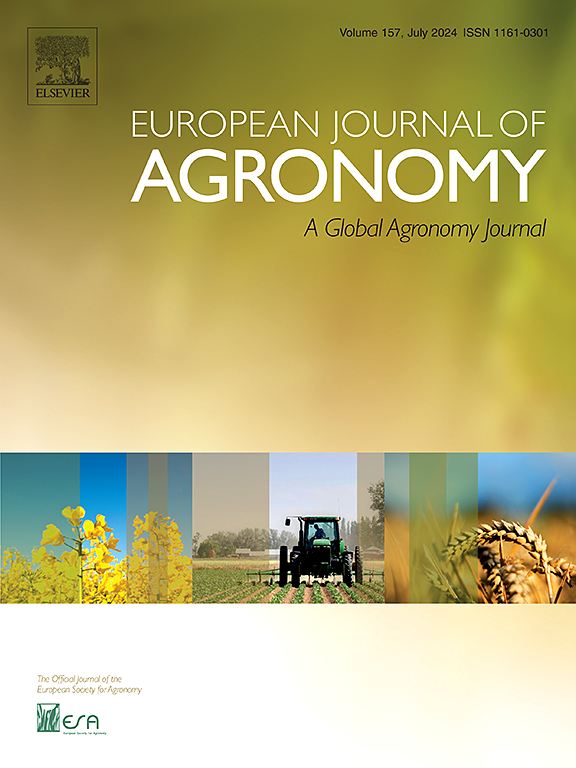Changes in the chemical fertility of a Mediterranean soil after the implementation of alley crops rotation in a mandarin orchard under regulated deficit irrigation
IF 4.5
1区 农林科学
Q1 AGRONOMY
引用次数: 0
Abstract
Intensive orchard monocultures in the Mediterranean region lead to environmental issues as soil erosion, soil organic matter loss and nutrient leaching. Alley cropping could serve as suitable strategy to improve soil fertility while increasing land productivity. This study aimed to assess the effect of different alley crop rotations on soil fertility and their effect on counteracting the effects of water stress on mandarin production. For this, three types of alley cropping with two different irrigation intensities were applied: i) a mandarin monoculture with bare alley soil, under both control irrigation (MM) and regulated deficit irrigation, RDI, (MMDI); ii) a multiple cropping of barley/vetch and fava bean, under both control irrigation (AC1) and RDI (AC1DI); and iii) a rotation of fava bean, purslane, and cowpea, under both control irrigation (AC2) and RDI (AC2DI). Soil samples were collected from two depths (0–10 cm and 10–30 cm) within the alleys, and different soil nutrients and cation exchange capacity (CEC) were measured. Chemical fertility in the MM treatment is relatively stable over time with time. A slight increase in the CEC was observed in AC1DI. In contrast, the AC2DI plots showed increases in B, P, and total nitrogen concentrations in subsurface samples. In terms of yield, this was significantly higher during the first year in MM, compared to AC1. Changes in production were similar in the three treatments. Average fruit size remained almost constant in MM but increased in AC1 and AC2. Regarding the productivity of the land, it decreased in MM and AC2 during the last year.
调亏灌溉条件下柑桔园轮作后地中海土壤化学肥力的变化
地中海地区果园的集约化单一栽培导致了土壤侵蚀、土壤有机质流失和养分淋失等环境问题。间作可以作为提高土壤肥力和提高土地生产力的适宜策略。本研究旨在评估不同旱作轮作对土壤肥力的影响及其对柑桔生产水分胁迫的抵消作用。为此,采用了3种不同灌溉强度的旱作类型:1)在控制灌溉(MM)和调节亏缺灌溉(MMDI)两种灌溉方式下,在光秃的旱作土壤上种植柑橘;ii)在控制灌溉(AC1)和RDI (AC1DI)下,大麦/豌豆和蚕豆的复种;iii)在控制灌溉(AC2)和RDI (AC2DI)下轮作蚕豆、马齿苋和豇豆。在小巷内0 ~ 10 cm和10 ~ 30 cm两个深度采集土壤样品,测定不同土壤养分和阳离子交换容量(CEC)。随着时间的推移,MM处理的化学肥力相对稳定。AC1DI组CEC略有升高。相比之下,AC2DI图显示地下样品中B、P和总氮浓度增加。就产量而言,与AC1相比,MM第一年的产量显著高于AC1。三种处理的产量变化相似。平均果实大小在MM中基本保持不变,但在AC1和AC2中有所增加。在土地生产力方面,MM和AC2在去年有所下降。
本文章由计算机程序翻译,如有差异,请以英文原文为准。
求助全文
约1分钟内获得全文
求助全文
来源期刊

European Journal of Agronomy
农林科学-农艺学
CiteScore
8.30
自引率
7.70%
发文量
187
审稿时长
4.5 months
期刊介绍:
The European Journal of Agronomy, the official journal of the European Society for Agronomy, publishes original research papers reporting experimental and theoretical contributions to field-based agronomy and crop science. The journal will consider research at the field level for agricultural, horticultural and tree crops, that uses comprehensive and explanatory approaches. The EJA covers the following topics:
crop physiology
crop production and management including irrigation, fertilization and soil management
agroclimatology and modelling
plant-soil relationships
crop quality and post-harvest physiology
farming and cropping systems
agroecosystems and the environment
crop-weed interactions and management
organic farming
horticultural crops
papers from the European Society for Agronomy bi-annual meetings
In determining the suitability of submitted articles for publication, particular scrutiny is placed on the degree of novelty and significance of the research and the extent to which it adds to existing knowledge in agronomy.
 求助内容:
求助内容: 应助结果提醒方式:
应助结果提醒方式:


